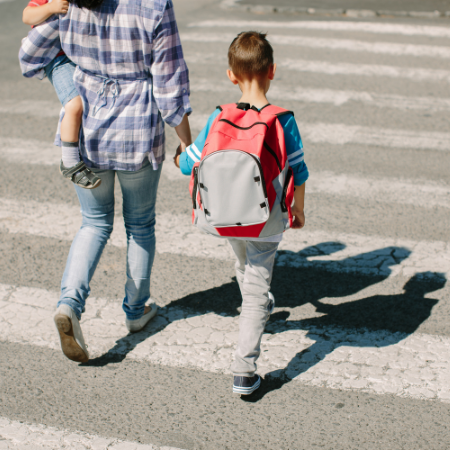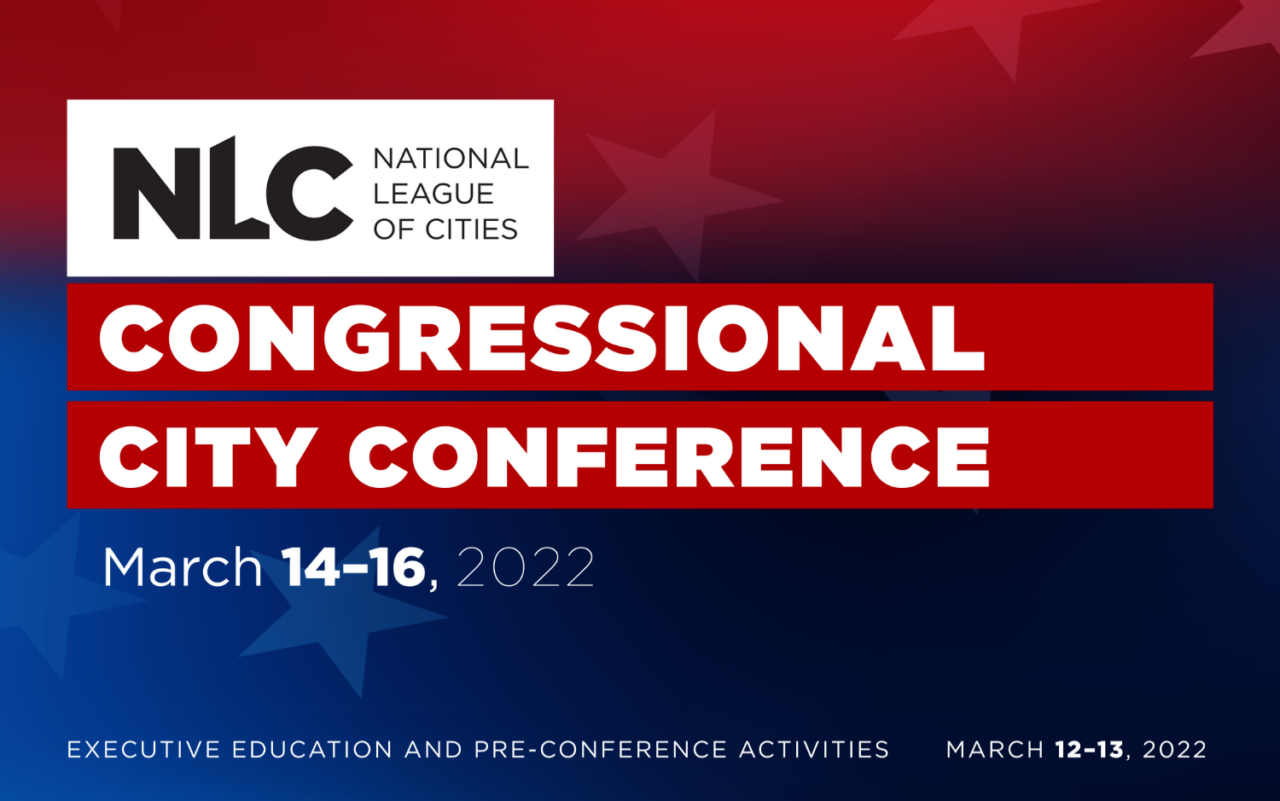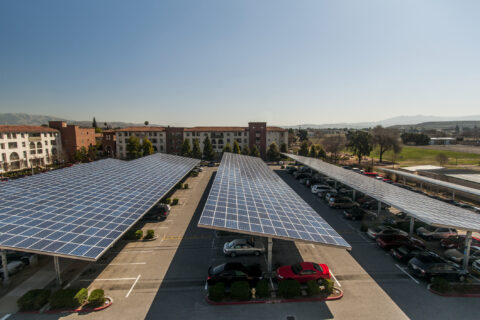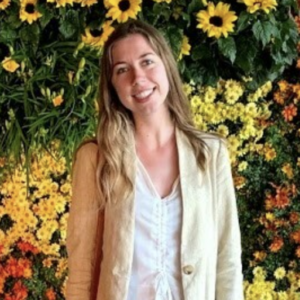Local leaders have been stepping up on roadway and pedestrian safety projects for years and calling for Vision Zero – a goal to eliminate all traffic fatalities and severe injuries. Now the U.S. Department of Transportation is leveraging this effort with a brand new comprehensive National Roadway Safety Strategy (NRSS), a roadmap for addressing the national crisis in roadway fatalities and serious injuries. The National League of Cities applauds USDOT for taking this first big action in 2022 on safety and remains committed to advancing road safety.

In November, NLC passed the 2022 National Municipal Policy Resolution for roadway safety, Advancing Safety for All to Reach Vision Zero with Policies that Achieve Safe, Healthy and Equitable Mobility for All, calling for national action and full attention to this issue at every level of government. To encourage and showcase further local leadership, in December NLC launched the Safety First Challenge for Safer Streets, an initiative to build a street safety coalition of 100 cities, towns and villages in 100 days.
To join the challenge, local leaders can commit to taking at least one “Challenge” action to advance street safety in their community. Most communities are already doing this, and the Challenge is a great way to highlight those efforts publicly which can lead to more awareness of the problem as well as bring more solutions forward. Here are the Seven Challenge Actions for the “Safety First Challenge:”
- Host a transportation safety roundtable with safety stakeholders from all corners of the community – emergency response, healthcare, transit, policymakers, real estate, non-profit groups, and community members, and others – to better understand and address safety needs.
- Gather data related to traffic safety in your communities, with an emphasis on addressing safety risks among disproportionately affected communities, including people walking and biking, seniors, children, people of color, and people in low-income communities.
- Engage in community neighborhood outreach on traffic safety problems and solutions, with an emphasis on the Safe System approach and disproportionately affected communities.
- Begin to utilize NLC and the U.S. Department of Transportation (USDOT) traffic safety resources to formulate and implement a Local Road Safety Plan, conduct and implement a Safety Audit, or initiate participation in the U.N.’s Decade of Action for Road Safety.
- Show what’s possible in the community by piloting a safety demonstration or safety intervention project, while gathering community input and analyzing safety impact.
- Prepare to utilize the “Safe Streets for All” program from USDOT by establishing a plan, partnerships, or community strategy.
- Pass a local resolution, Local Road Safety plan, or other purpose-driven safety commitment that advances additional actions based on the Safe System approach.

Every city and town across the U.S. is impacted by road deaths of drivers, riders and pedestrians, and city leaders remain committed to acting with our federal partners to make our streets and roads safer for all our residents. Here are just a few of the reactions from across the country from cities of all sizes that see safety as a priority:
“America’s cities, towns and villages applaud Sec. Buttigieg’s new National Safety Strategy that spotlights safety at the ground level in in our communities. Making safety a priority starts with us in each of our cities, towns and villages but important choices about road design and spending at the national and state level impact our residents who are just trying to make it to their jobs or back home. We need partnerships and resources this new strategy envisions so we can make our residents safer. Safer streets will save lives – that is a goal we can all share.” — Council President Elaine Clegg, City of Boise, ID, Chair of NLC’s Transportation and Infrastructure Services Committee
“America’s local leaders have seen far too many of our neighbors losing their lives on our roads so it’s time to use our national presence in every community to challenge the status quo. City leaders know focusing on safer streets can save lives, decrease traffic crashes and ensure that every one of our residents makes it home safely. I encourage all our local leaders to join us in the Safety First Challenge because together we can save lives and make our streets safer.” – NLC President Vince Williams, Mayor of Union City, Georgia
“Traffic injuries and deaths on our nation’s roadways are an ongoing tragedy – made worse because we know that this injury and death is preventable. By modifying our approach to roadway design, vehicle design, traffic speeds, human behavior, and post-crash care, the United States can make significant progress towards making our streets safer for everyone. That’s why I am excited about the announcement of the US Department of Transportation’s National Roadway Safety Strategy and its ‘Safe System Approach.’ I’m hopeful this new framework will have a meaningful impact on safety in communities like Doraville and beyond.” — Mayor Joseph Geierman, City of Doraville, GA, and NLC Transportation Infrastructure and Safety Committee Vice Chair.
“As safety is our collective responsibility, we look forward to working with our partners at the national and state level to secure the resources necessary to upgrade our transportation system to be safer and more equitable for residents of and visitors to Las Vegas. The implementation of Sec. Buttigieg’s National Safety Strategy creates a roadmap for increasing emphasis on and securing funding for safety projects that will save lives.” — Councilman Brian Knudsen, City of Las Vegas, NV.
“The City of Kansas City has some of the highest mortality and injury rates per capita related to traffic, especially in neighborhoods experiencing historical disinvestment. I am committed to the USDOT Safe Streets for All program and Kansas City looks forward to participating in the Safety First Challenge.” — City Councilmember Melissa Robinson, Kansas City, MO, member of the NLC Transportation Infrastructure and Safety Committee.
“Emmett applauds NLC’s new National Safety Strategy that spotlights safety at the ground level in America’s communities. The best safety starts on the ground with local mayors and city councils utilizing not just local resources but leveraging those resources available at state and national levels to make the right choice when it comes to roads and always insisting they be designed for safety. Our city council has already adopted the concept of making our streets safer as we move forward, and we warmly welcome this partnership as it provides us with the resources to keep our residents not only safer, and as an added bonus, healthier by improving our walkability! With this new partnership, our goal of safer streets is virtually ensured.” — Mayor Gordon Petrie, Emmett, ID.
“I want to thank Secretary Buttigieg and USDOT for creating a comprehensive approach to transportation safety and for calling on communities across America to reduce and eventually eliminate serious injuries and deaths on our roadways. In Madison, we are committed to creating an environment where the community feels safe on our streets when walking, biking, taking transit or driving to work, school, or wherever they may need to go. Working together with the community, we will build a positive safety culture and improve our design and construction process to ensure that our streets are accessible for all people regardless of their age, ability, gender, race or method of travel.” — Mayor Satya Rhodes-Conway, Madison, WI.
“Bellevue is grateful for the USDOT’s leadership in developing the National Safety Strategy to support our shared goal of zero fatalities and serious injuries for the transportation system. Through collaboration, improved street design, safe speeds, improved data and a culture of safety, we will save lives,” said “Making our streets safer will have far-reaching consequences. It will encourage more people to walk and bicycle, enhancing their well-being, and positively impact the environment. We look forward to working with the USDOT to improve safety for everyone.” — Mayor Lynne Robinson, Bellevue, WA.
The Vision Zero Network reports that cities are also driving change in safety in alignment with their other strategic goals of safe systems, equity, and sustainability:
- Many cities are choosing to prioritize safety over speed by lowering their speed limits, including Minneapolis & St. Paul, Denver, San Francisco, and Charlotte.
- Seattle recently announced it will deprioritize low-risk public safety violations, including biking without a helmet and expired/missing vehicle registrations. These will no longer serve as primary reasons to make traffic stops, given concerns about racial and economic inequities in enforcement.
- The State of Colorado’s new policy will require transportation projects to measure climate impacts and incentivize funding for green mobility options, such as transit, walking, and biking.
Cities know that focusing on safer streets will save lives, decrease traffic crashes and improve safety for everyone on our streets and sidewalks. As we all work together to improve the safety of our roads, sidewalks and trails, we echo the sentiment of former Mayor and U.S. Transportation Secretary Pete Buttigieg, “We cannot tolerate the continuing crisis of roadway deaths in America.”
Join the Safety First Challenge today!

Register for the Congressional City Conference, March 14-16 in Washington, DC to engage directly with federal agency leads on programs available to local governments under ARPA and the Bipartisan Infrastructure law.











